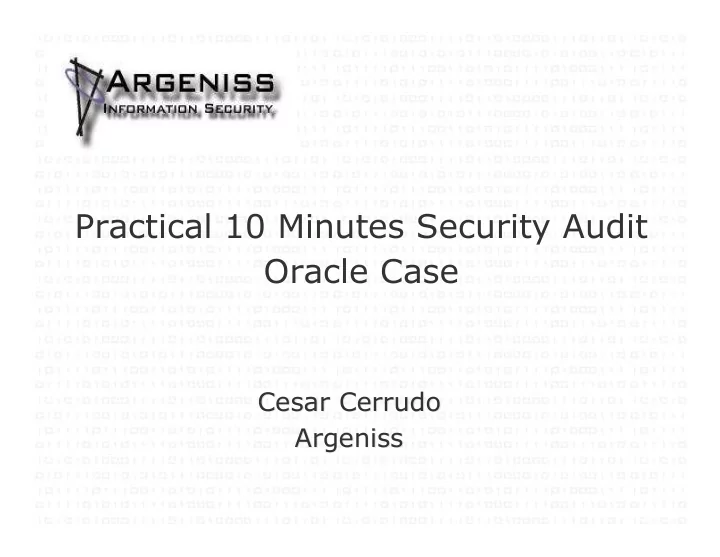

Practical 10 Minutes Security Audit Oracle Case Cesar Cerrudo Cesar Cerrudo Argeniss Argeniss
Overview ● Introduction ● The technique ● Finding 0days in Oracle ● Getting technical ● Owning Oracle ● Conclusions ● References
Introduction • Sometimes it's needed a way to infer how trustable and secure a software is before purchasing and/or deploying • A full auditing takes a lot of time and resources • A quick and very easy audit technique can help – It can be done by non very technically skilled people – It reduces auditing time and costs – Many of these kind of techniques can be combined for better results – If you can find issues in a couple of minutes then you can be almost sure that the software is not very secure
The technique • This technique is for easily and quickly auditing Windows applications • It is as simple as looking at process objects identifying weak permissions – Weak permissions allow object manipulation by unprivileged users • Changing permissions on objects can crash the process • Depending on the object type sometimes is even possible to get arbitrary code execution as it will be demonstrated later
The technique • The following tools are needed: – Process Explorer – WinObj – Pipeacl Tools • Install and run the software to be audited • Identify software processes – Mostly we should care about privileged process like services – Regular processes should be audited if the application will be used in a shared environment such as Terminal Services, Citrix, etc. – Demo
The technique • Start looking at process objects permissions – Look at named objects created by the process that can be opened from other processes such as events, mutexes, semaphores, sections, pipes, threads, etc. – Demo • Identify weak permissions – Look for low privileged accounts with “Change Permissions” or “Write DACL” permissions – If no groups or user accounts are listed then the object was created with a null DACL • Then all users have full control over the object – Demo
The technique • Change permissions on objects found and interact with the audited application – Process Explorer doesn't let to edit permissions on some objects • WinObj and Pipeacl tools can help – Look if the application crash or stop responding
Findings 0days in Oracle • Let's see the technique in action • Let's audit Oracle 10g R2 – Extremely secure software – In house audited with next generation tools – The proud of Oracle security engineering – Hard challenge for finding vulnerabilities – It makes Windows unbreakable • Demo
Getting technical • Objects weak permissions problem is because improper use of SetSecurityDescriptorDacl() function – If third function parameter (pDacl) is set as NULL a NULL DACL is assigned to the security descriptor and no protection is assigned to the object – Documented on MSDN • It seems some Oracle people is allergic to read Microsoft related stuff – Identifying bad usage of SetSecurityDescriptorDacl() function is a 5 minutes IDA job • Demo
Getting technical • Oracle has always nice surprises for us – SetKernelObjectSecurity() is being used for changing the DACL on the process – Looking at process permissions we can see Everyone group has PROCESS_DUP_HANDLE rights – Why would someone do that? • Maybe it's on Oracle superior secure coding guides • Very bad design and coding – Let's see now how to exploit it
Owning Oracle • With PROCESS_DUP_HANDLE rights, how can we get arbitrary code execution? – We can duplicate data files handles and read all the data but we want arbitrary code execution – We can duplicate impersonation tokens but low privileged users can't impersonate :( – What about duplicating a thread and changing context to execute our code? • We only need a way to put our code at known location • We can put the code in the shared section we previously saw (remember it has full permissions for Everyone) – Demo
Conclusions • Very easy and quick technique • Just making click on proper tools you can quickly identify these vulnerabilities • If you like to work at low level, using IDA to identify these vulnerabilities is even faster • Most of these vulnerabilities can be exploited to just cause a DoS but in some cases they can be exploited to run arbitrary code
Conclusions • Total spent time: 10 minutes • Skills needed: none • Number of vulnerabilities found: 5 or more • Oracle database versions affected: ALL • PoC exploit code provided: YES • Money invested: $ 0.00 • Having fun with Oracle software and pointing out Oracle security excellence: priceless Oracle continues showing that it's extremely hard to break!
References • Thunder and MAD weblog http://blogs.oracle.com/maryanndavidson/ • Process Explorer http://www.sysinternals.com • WinObj http://www.sysinternals.com • Pipeacl Tools http://www.bindview.com/Services/razor/Utilities/Windows/pip eacltools1_0.cfm • WLSI – Windows Local Shellcode Injection http://www.argeniss.com/research/WLSI.zip
References • Hacking Windows Internals http://www.argeniss.com/research/hackwininter.zip • SetSecurityDescriptorDacl() API http://msdn.microsoft.com/library/default.asp?url=/library/en- us/secauthz/security/setsecuritydescriptordacl.asp • SetKernelObjectSecurity() API http://msdn.microsoft.com/library/default.asp?url=/library/en- us/secauthz/security/setkernelobjectsecurity.asp
Fin ● Questions? ● Thanks ● Contact: cesar>at<argeniss>dot<com Argeniss – Information Security http://www.argeniss.com/
Recommend
More recommend